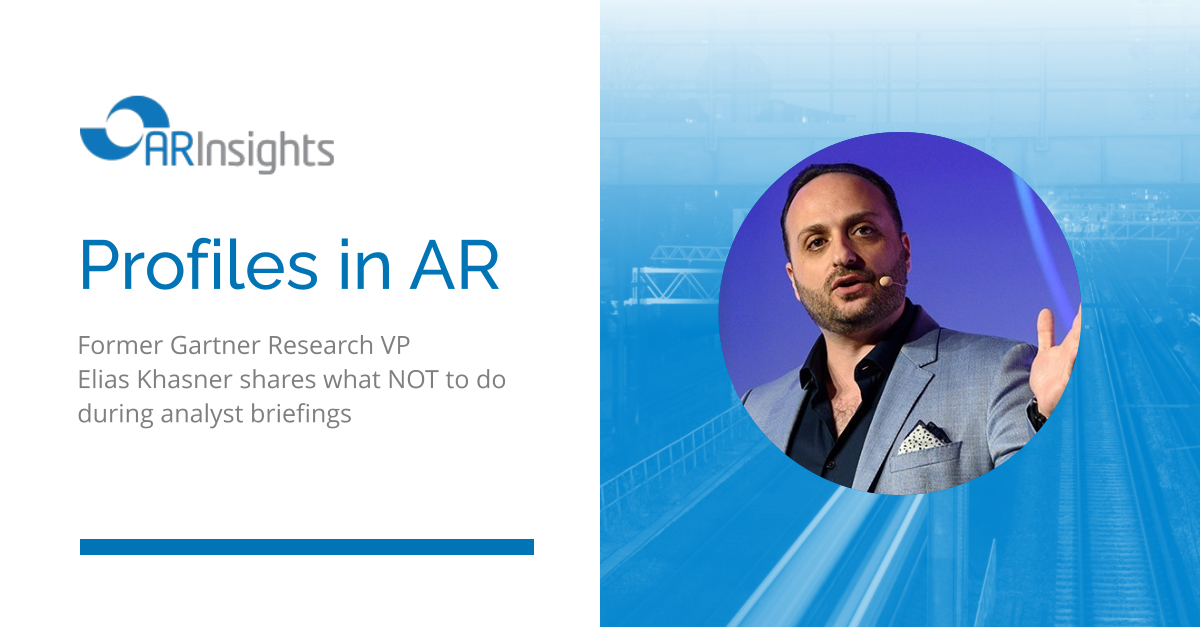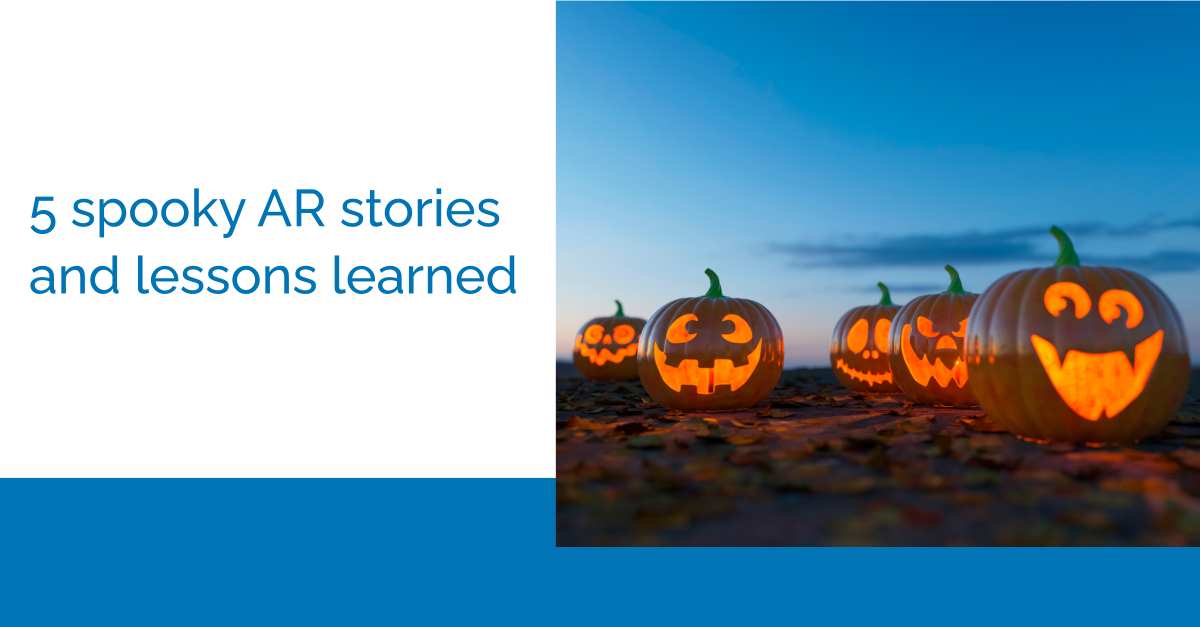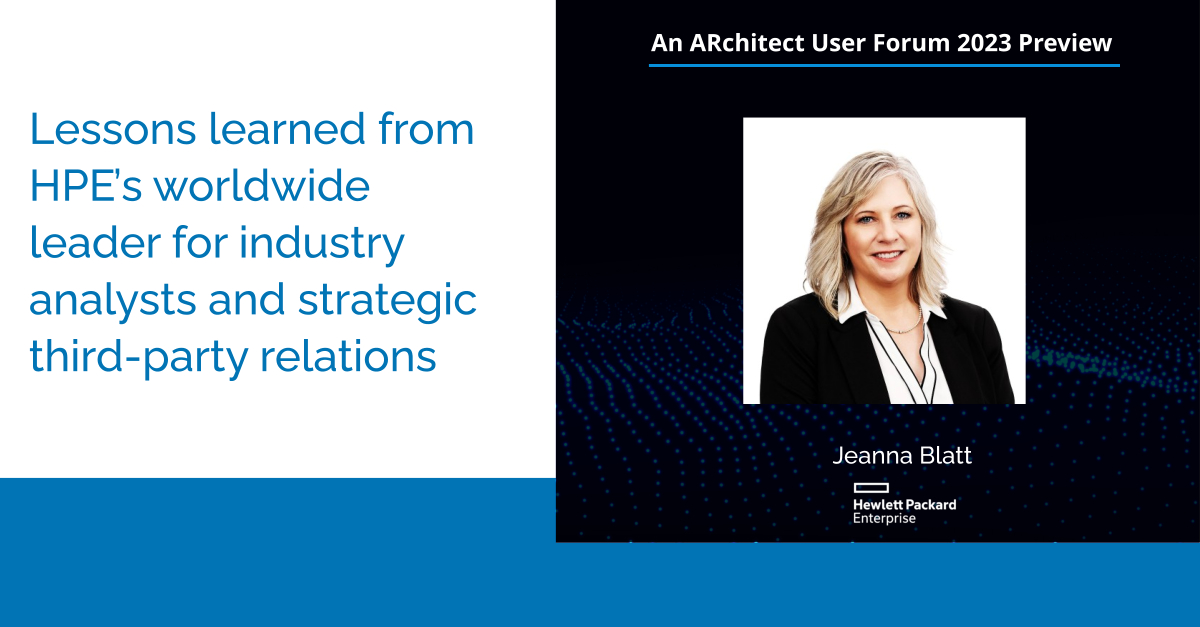Analyst relations (AR) readers, get ready to absorb some more terrific information and advice!
We’re bringing you Part II of our “Profiles in AR” interview with Elias Khnaser, former research VP at Gartner, where he covered cloud and data center trends for seven years. Elias is now chief of research for EK Media Group and also regularly posts to his YouTube channel, where he hosts video podcasts, often with other former Gartner analysts and additional guests.
If you missed Part I of Elias’ interview, check it out here – it’s a great take on what differentiates good AR professionals from great ones, and how to build strong relationships with analysts.
The rest of our conversation (including Magic Quadrant “secrets for success”) is below.
Q: We’ve been enjoying the videos on your YouTube channel – in particular, “Let’s Talk Shop.” When booking guests, do you interact more with AR or PR pros?
Elias: Because I’ve worked with AR folks the last seven years [while at Gartner], most of my contacts are coming through AR or introductions that AR has made. There are also media contacts who have reached out to me. And I’m reaching out to some guests, myself, because I feel like they have something intriguing to offer. But by all means, if anyone has a suggestion for a guest, drop me an email.
Q: From your time at Gartner, can you speak to the volume of meetings that analysts have?
Elias: Gartner analysts easily have 1,000+ interactions each year! In that count, I’m including phone and video conversations, one-on-ones during conferences, and so on. That doesn’t include email. It’s not uncommon for a Gartner analyst to take five, six, seven calls in a day. And video has become a pretty standard format for those calls.
Q: WOW! Talk about information overload. Given the volume of interactions, what’s the best way for AR pros to make their companies stand out?
Elias: Here, I’m going to be brutally honest. There’s only so much information a person can consume and so many companies they can track. That’s the challenge.
For me, there was always a set of companies that was core to my research. They were the hyperscale cloud providers: AWS, Azure, Google, IBM. But in the cloud space, there were also other companies I had to keep an eye on, that I couldn’t ignore.
So for organizations, I would say you need to find the analyst where your company is core to their research. Because when it comes to catching an analyst’s attention, the “cores” are in an advantageous position.
For everyone else, it’s usually a matter of catching the analyst at conferences and making sure you have face time. Also, when there’s something truly differentiating that your organization is announcing, then you can often get an analyst’s attention.
So for AR folks, it’s helpful to know, “Hey, I’m not core to this analyst, and as a result, I shouldn’t inundate them because it’s just not going to go anywhere.” My advice would be to reach out when you have something to say that will be impactful.
On the other hand, if you are core to the analyst’s research, you can get away with sending a lot more information. Sorry — that’s harsh but true!
Q: As AR pros and their companies participate in Magic Quadrants and other influential Gartner reports, can you share any “secrets for success” or best practices?
Elias: Engage early! A great analyst relations person understands the publishing schedule of their analysts. Great AR folks will schedule a meeting toward the beginning of the year to say, “Hey, what are you working on this quarter? How far ahead are the reports you have planned?”
They’ll get a list with tentative publishing dates. For the Magic Quadrant, AR pros can also say, “When do you start researching? How can we help? We might have some input, ideas and criteria, based on what we’re hearing from customers.”
Understanding the timeline allows you to offer input — which may be taken or not, but at least you have the opportunity.
Now in my role at Gartner for Technical Professionals, I didn’t work directly on Magic Quadrants. But I did work on criteria and scorecards documents, which were technical in nature and fed into the MQs.
So for the criteria that went in there, we would have conversations with the participating vendors. Emails would go out to all of them, sharing the timeframe when we were accepting feedback on criteria. So that’s also a great opportunity for analyst relations folks and their companies — if they want to offer up criteria, propose tweaking criteria or have a conversation on criteria.
Those are all very, very good conversations to have early on, because that’s the time when things can change.
Q: What are some must-haves in an analyst briefing deck?
Elias: Here, it depends. If it’s a first-time briefing, and the analyst doesn’t know anything about your company or product, I think the deck needs to show who the company is, who the executives are and — if it’s a start-up — who funds it. That lends a lot of credibility. And then talk about the product and positioning.
Once you have a relationship, or if you’re with a well-established company, don’t bury the lead in a briefing. Try to get to the point early on in the deck.
Sometimes, I’ve been on calls where the purpose was to talk about an upcoming announcement. But by the time we get to the slides on that, we’ve wasted 25-30 minutes with prepping type of stuff.
I used to give this same advice to analysts writing reports. Your most important points need to be at the top of the document, early on. The same applies here, for vendors. When you’re doing a briefing and you already have a relationship, just dive into things. You’re going to have the most attention early on in the call. If you grab analysts’ attention at that point, then you’re going to have it for the remainder of the conversation.
Q: Are there any other common mistakes companies make on briefings and inquiries? How can they optimize their time?
Elias: Well, here’s another piece of advice that may be helpful: Try to not waste too much time on introductions. Especially the types of introductions where everyone goes around the room. If there’s an analyst relations person on the call, that person can introduce everyone quickly. But again, let’s not spend 10 minutes on intros. Jump into the subject matter quickly, and get to the point.
Another common mistake was when vendors, especially ones that hadn’t engaged as much with Gartner, would try to game the system, so to speak. They’d try to combine a vendor briefing and an inquiry on the same call. And that’s unfair to their company and to the analyst too.
At least by Gartner standards, vendor briefings [available to Gartner clients and non-clients] are supposed to largely be a one-way flow of information — you’re giving information; you’re sharing your perspective. And while the analyst isn’t just going to be silent, it’s not really intended to be a two-way conversation or dialogue. Inquiries, on the other hand, are scheduled time for clients to pick the analyst’s brain and ask for feedback.
But what I’ve seen is that during briefings, some organizations try to introduce who they are, and then they’ll start asking for feedback and input: “What do we do here; what do we do there?”
This is where the personality of the analyst will come into play. Some will shut it down immediately and say, “Please go ahead and schedule an inquiry on that.” Others will entertain the questions for a few minutes and then say, “Folks, we really need to transition to an inquiry.” Either way, when companies do this, it’s a bit annoying because it puts the analyst in an uncomfortable position. As we talk about good vs. great AR people, a great one wouldn’t do this.
Q: We enjoyed your “Is Gartner Pay to Play?” video on your YouTube channel recently. (Readers: It’s worth watching in its entirety – but the short answer to the question is no, Gartner is not!) What motivated you to make the video, and what kind of reception did it get?
Elias: That video has been very, very, popular. I didn’t realize that many people would be interested! It got a lot of views, and two journalists, who were working on separate stories, reached out after seeing it too.
It was a sincere video. As for the motivation behind it, I’ll be honest: At first, after I left Gartner, I would have conversations with people — some I’d known for years, some I hadn’t — and they’d say, “Yea, we know how it works at Gartner…” [implying it was pay-to-play]. And they’d wink. The wink just drove me crazy.
For the most part, I’d let it go; I’m not going to change everyone’s opinion. But there was one person who kind of hit a nerve with me. That person used to work for a different analyst firm and is now with a vendor, and basically said, “Well, I know how this works.” With the wink! And then started rattling off: “I understand that you have to give a certain amount of quotes to vendors — so the more they quote you in their marketing materials and on stage, the more compensation you get.” And so on.
The comments didn’t register with me at first, but they bothered me!
A couple days later, I contacted a friend and said, “What did this person mean?” They explained to me that, yes, there are analyst firms like that, that will have their analysts provide lots of quotes and compensate based on if someone picks the quotes up.
And that knowledge motivated me. I spent seven years of my life at Gartner. Gartner isn’t perfect — no company is! But I’m a very passionate person about my work… and maybe a little too defensive. I wanted to set the record straight that we don’t work like that. And then when I did some research online, I also thought there might be some interest in this topic.
Q: In the future, do you see AR programs evolving into broader influencer relations efforts?
Elias: That’s a great question. I do think there’s an intersection. Lots of organizations today have an AR team, but they also often have a separate influencer team. And then there’s marketing too. So all three tend to overlap in some cases, especially the influencer and analyst relations pieces.
Personally, I can see the need for AR folks to be separate, though, just because I can appreciate how busy they are. Analysts don’t make it easy, especially when there are a lot of reports they need to publish. I’ve also seen analyst relations folks that are very, very technical. I was truly impressed. Anyway, I know they all have a lot on their plates!
Still, I feel like the roles are converging and are, to some degree, redundant since many influencers are one-man analyst shops. And the thing is — you can’t ignore these influencers; some have built big followings, and their messages are hitting very quickly, often more so than with traditional analysts. So I do think there’s overlap, and there will be some consolidation moving forward.
Q: Is there anyone else you’d recommend for this series?
Elias: I have a few former colleagues who would be fun to talk to; you’d probably get similar perspectives. Sanjeev Mohan used to be an analyst at Gartner, focused on data and analytics primarily. He’s working independently now and would be interesting to talk to.
Anna Belak also used to work as an analyst at Gartner and is working with a security firm now. It would be an enjoyable conversation with her, for sure.
Q: This has been a great conversation! Is there anything else you’d like to add?
Elias: Thank you very much for the opportunity. I wish all the AR folks out there, or those who are aspiring to be in analyst relations, the best of luck. They’re getting into a tough job, I would say. It’s really tough to deal with analysts in general, so make sure you have some thick skin if you’re getting into this game.
***
A million thanks to Elias for his time and insights! If you want to connect with Elias, you can reach him on LinkedIn.
And stay tuned for more interviews in our Profiles in AR series.




